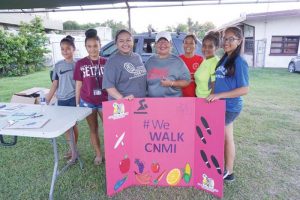Restarting village activities to fight diabetes

Diabetes Prevention & Control Program coordinator Amber Lynn Mendiola, third from left, Rep. Alice Igitol, and Non-Communicable Disease Division of Public Health Jessie de los Reyes are surrounded by Igitol’s grandchildren at the #WeWalkCNMI event at Tanapag Middle School last Thursday. (Bea Cabrera)
November is National Diabetes Month. In line with this, whether you have the disease or not, getting everyone to start being physically active in the community is the main goal of the Diabetes Prevention & Control Program of the Commonwealth Healthcare Corp.
Citing the 2016 Non-Communicable Diseases and Risk Factor Hybrid Survey Report, program coordinator Amber Lynn Mendiola said that 33 percent of CNMI adults reportedly do not do any physical activity or exercise.
“In honor of Diabetes Month on Saipan, Tinian, and Rota, we started this mini-walking campaign called #WeWalkCNMI. This is to show families that they can walk together and do something as simple as that and this gave us the idea to restart village activities,” she said.
“We came up with walking sites in villages that are marked and safe, away from cars because we wanted to showcase spaces that are safe to walk, where they can just do it on their own. The lack of physical activity has been linked to chronic diseases like diabetes,” Mendiola added.
#WeWalkCNMI started last Nov. 14 at Laolao Bay Golf & Resort pathway and last Thursday at the Tanapag Middle School. It continues on Nov. 21 at the Garapan Public Market and at Coral Ocean Point, Nov. 28 at the Dandan Baseball Field. The last event will be on Nov. 30 at Oleai and Kilili pavilions.
The Tanapag Middle School leg last Thursday was joined by Rep. Alice Igitol (R-Saipan). She said a lot of families are diabetic “so we would like to encourage them to walk and do physical activities because these will help them have a longer life.”
“Although I am not diabetic, I want to participate in this event and brought my grandchildren to be part of it. I hope the community can see that they can be a part of this too,” she added.
Studies show that 90 percent of people with diabetes have Type II diabetes, the type of diabetes responsible for killing many people in the CNMI.
CHC physician Dr. Beth Kohen said that diabetes, also called diabetes mellitus or sugar diabetes, is very common in the CNMI and is a major contributor to longterm illness, disability, and death. To understand diabetes, one needs to understand what a hormone is.
“A hormone is a substance made in one place of the body that acts somewhere else. It is a chemical command from a gland to a distant body part, usually transported by the blood stream. It is like a key made in the machine shop but opens a door at the other end of a building.”
“For a hormone to be effective, it needs to be in the right place, at the right time, in the right amount, and in the right pattern—it needs to be the right key in the right door turned in the correct direction in a lock that is lubricated and able to move,” she added.
Kohen said that insulin, the hormone involved in diabetes, is made in the pancreas and circulates through the blood to affect the movement of glucose in and out of the cells all over the body. Cells are the building blocks of all of our organs and tissue and cells need glucose as fuel and insulin is the key that opens the cell to let the food in.
“Diabetes is caused by an unreliable, absent, or broken insulin key or a sticky and unresponsive cell lock mechanism. If the insulin key is missing, damaged, does not work at the right time or if the final lock into the cell is broken, cells do not eat. That is a big problem. That is diabetes.”
Kohen said that treatment for type II diabetes is more variable but getting physically active is No. 1 on the list to prevent and manage diabetes.
“Exercise opens the locks even without a key and lets the glucose in to strengthen cells. Losing weight lubricates the locks so the insulin key can turn. Eating a proper low-glucose diet can limit the amount of glucose inn the bod. …Medication can help your natural keys to be more effective or your locks to be more receptive,” she added.
Mendiola expects the event to start small group but is positive that it will attract more people.
“We knew that the beginning is going to be small but it’s okay if we at least get a couple of families together and one person to be aware of diabetes and how important exercise is. We want to keep it going so that more and more people can be a part of it.”
“We plan to have more events in the future aside from having walks. We definitely plan to follow through and keep showing these example sites so people can utilize them on their own because we want to inform people more about diabetes and exercise,” Mendiola added.



























